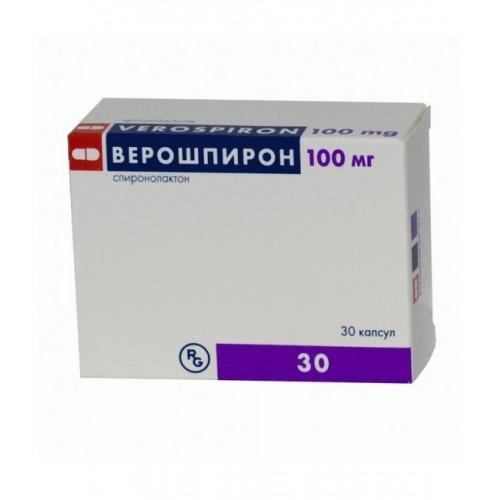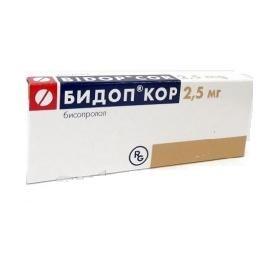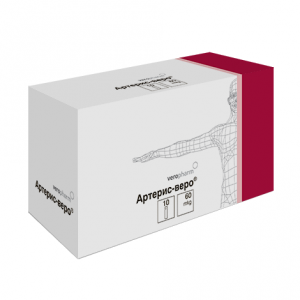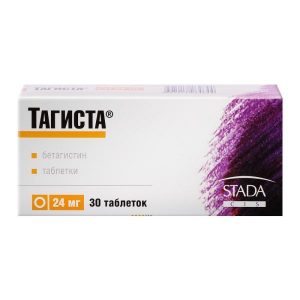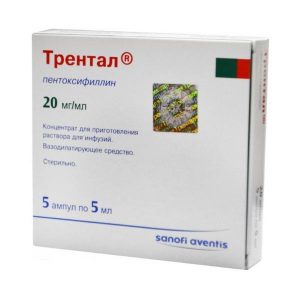Description
Latin name
Verospiron
Release form
Capsules.
Packing
30 pcs
Pharmacological action
Veroshpiron-potassium-sparing, diuretic.
Pharmacodynamics
Spironolactone is a potassium-sparing diuretic, a specific antagonist of aldosterone (mineralocorticosteroid hormone of the adrenal cortex) prolonged action.
In the distal nephron, spironolactone interferes with the retention of sodium and water by aldosterone and inhibits the potassium-excreting effect of aldosterone, reduces the synthesis of permeases in the aldosterone-dependent portion of the collecting tubules and distal tubules. By binding to aldosterone receptors, it increases the excretion of sodium, chlorine and water ions in the urine, reduces the excretion of potassium and urea ions, and reduces the acidity of urine.
Increased urine output due to the presence of a diuretic effect, which is unstable diuretic effect manifests itself on the 2nd 5th day of treatment.
Pharmacokinetics
Absorption and distribution
When taken orally, it is rapidly and completely absorbed from the digestive tract. It binds to plasma proteins by approximately 98% (canrenone – 90%). Tmax of canrenone in blood plasma – 2 4 hours. After daily intake of 100 mg of spironolactone for 15 days, Cmax reaches 80 ng / ml, Tmax after the next morning dose – 2 6 hours. Vd – 0.05 l / kg.
Metabolism
Spironolactone is converted into active metabolites: a metabolite containing sulfur (80%) and partially into canrenone (20%). Spironolactone penetrates poorly into organs and tissues, while it and its metabolites cross the placental barrier, and canrenone passes into breast milk.
Excretion
Excreted by the kidneys: 50% – in the form of metabolites, 10% – unchanged and partially through the intestines. T1 / 2 of spironolactone – 13-24 hours, active metabolites – up to 15 hours. Canrenone excretion (mainly by the kidneys) is two-phase, T1 / 2 in the first phase – 2-3 hours, in the second – 12 96 hours.
With cirrhosis and heart failure: the duration of T1 / 2 increases without signs of cumulation, the likelihood of which is higher with chronic renal failure and hyperkalemia.
Indications
Essential hypertension (as part of combination therapy).
Edema syndrome in chronic heart failure (can be used as monotherapy and in combination with standard therapy).
States, in which secondary hyperaldosteronism can be detected, including cirrhosis of the liver, accompanied by ascites and / or edema, nephrotic syndrome and other conditions accompanied by edema.
Hypokalemia / hypomagnesemia (as an aid to its prevention during treatment with diuretics and when it is impossible to use other methods of correcting potassium levels).
Primary hyperaldosteronism (Conn’s syndrome) – for a short preoperative course of treatment.
To establish a diagnosis of primary hyperaldosteronism.
Contraindications
Addison’s disease.
Hyperkalemia.
Hyponatremia.
Severe renal failure (CC less than 10 ml / min).
anuria.
Lactose intolerance, lactase deficiency, glucose / galactose malabsorption syndrome.
Pregnancy.
Lactation (breastfeeding).
Children under 3 years old.
Hypersensitivity to the drug.
With caution: the drug should be prescribed for hypercalcemia, metabolic acidosis, AV block (hyperkalemia enhances it), diabetes mellitus (with confirmed or suspected chronic renal failure), diabetic nephropathy, surgical interventions, taking drugs that cause gynecomastia, local and general anesthesia, menstrual irregularities, breast enlargement, liver failure, liver cirrhosis, as well as elderly patients .
Pregnancy and lactation
Veroshpiron is contraindicated in pregnancy and lactation.
If you need to use the drug during lactation, breastfeeding should be discontinued.
Composition
1 capsule contains:
Active ingredient:
spironolactone – 100 mg.
Excipients:
sodium lauryl sulfate – 5 mg,
magnesium stearate – 5 mg,
corn starch – 85 mg,
lactose monohydrate – 255 mg.
Composition of hard gelatin capsule:
lid – sunset sunset dye yellow (E110) – 0.04%,
titanium dioxide (E171) – 2%,
gelatin – up to 100%
case – sunset dye yellow (E110) – 0.04 %,
titanium dioxide (E171) – 2%,
dye quinoline yellow (E104) – 0.5%,
gelatin – up to 100%.
Side effects of the
From the digestive system: nausea, vomiting, diarrhea, ulceration and bleeding from the digestive tract, gastritis, intestinal colic, abdominal pain, constipation, impaired liver function.
From the side of the central nervous system and peripheral nervous system: ataxia, lethargy, dizziness, headache, drowsiness, lethargy, confusion.
From the hemopoietic system: agranulocytosis, thrombocytopenia, megaloblastosis.
From the side of metabolism: hyperuricemia, hypercreatininemia, increased concentration of urea, hyperkalemia, hyponatremia, metabolic hyperchloremic acidosis or alkalosis.
From the endocrine system: coarsening of the voice, in men – gynecomastia (the probability of development depends on the dose, duration of treatment and usually is reversible and after discontinuation Veroshpirona disappears, only in rare cases the mammary gland remains slightly increased), decreased potency and erection in women – menstrual irregularities, dysmenorrhea, amenorrhea, menorrhagia in the menopause, hirsutism, pain in the area of the mammary glands, breast carcinoma (no connection with the drug has been established).
Allergic reactions: urticaria rarely – maculopapular and erythematous rash, drug fever, pruritus.
Dermatological reactions: alopecia, hypertrichosis.
Urinary system: acute renal failure.
From the musculoskeletal system: muscle spasm, spasms of the calf muscles.
Drug Interaction
Verospiron reduces the effect of anticoagulants, indirect anticoagulants (heparin, coumarin derivatives, indandion) and toxicity of cardiac glycosides (as normalization of potassium level in the blood impedes development).
Increases the metabolism of phenazole.
Reduces the sensitivity of vessels to norepinephrine (requires caution when carrying out anesthesia).
Increases T1 / 2 digoxin, so digoxin intoxication is possible.
Increases the toxic effect of lithium by reducing its clearance.
Accelerates the metabolism and elimination of carbenoxolone.
Carbenoxolone promotes sodium retention with spironolactone.
GCS and diuretics (benzothiazine derivatives, furosemide, etacric acid) enhance and accelerate diuretic and natriuretic effects.
Increases the effect of diuretic and antihypertensive drugs.
ACS increase the diuretic and natriuric effect in hypoalbuminemia and / or hyponatremia.
Increases the risk of developing hyperkalemia when taking Veroshpiron with potassium drugs, potassium supplements and potassium-sparing diuretics, ACE inhibitors (acidosis), angiotensin II antagonists, aldosterone blockers, indometospacin.
Salicylates, indomethacin reduce the diuretic effect.
Ammonium chloride, cholestyramine promote the development of hyperkalemic metabolic acidosis.
Fludrocortisone causes a paradoxical increase in tubular secretion of potassium.
Reduces the effect of mitotane.
Increases the effect of tryptorelin, buserelin, gonadorelin.
Overdose
Symptoms: nausea, vomiting, dizziness, decreased blood pressure, diarrhea, skin rash, hyperkalemia (paresthesia, muscle weakness, arrhythmias), hyponatremia (dry mouth, drowsiness, drowsiness).
Treatment: gastric lavage, symptomatic treatment of dehydration and hypotension. In hyperkalemia, it is necessary to normalize the water-electrolyte metabolism with the help of potassium excreting diuretics, rapid parenteral administration of dextrose solution (5-20% solutions) with insulin at the rate of 0.25-0.5 IU per 1 g of dextrose, if necessary, re-introduction of dextrose. In severe cases, hemodialysis is performed.
Storage conditions
Keep out of the reach of children at a temperature not exceeding 30 ° C.
Expiration
5 years.
Deystvuyuschee substances
spironolactone
dosage form
dosage form
capsules
